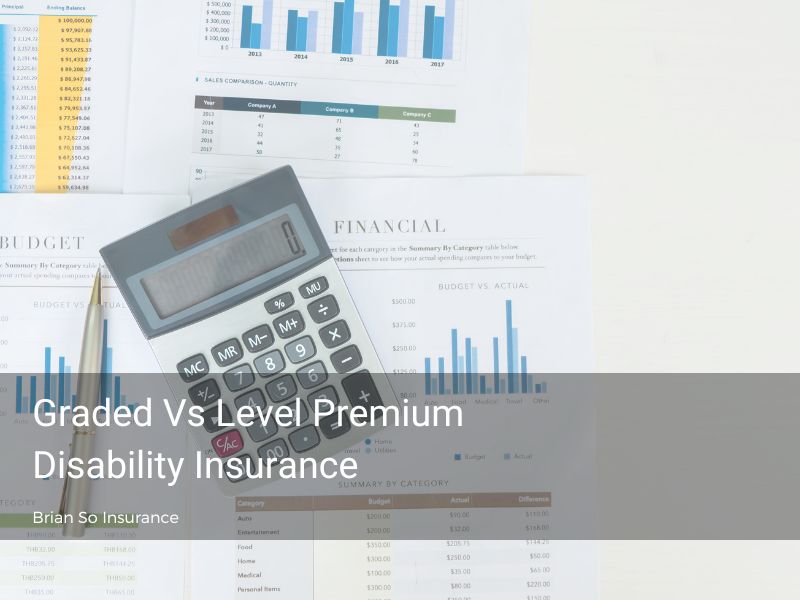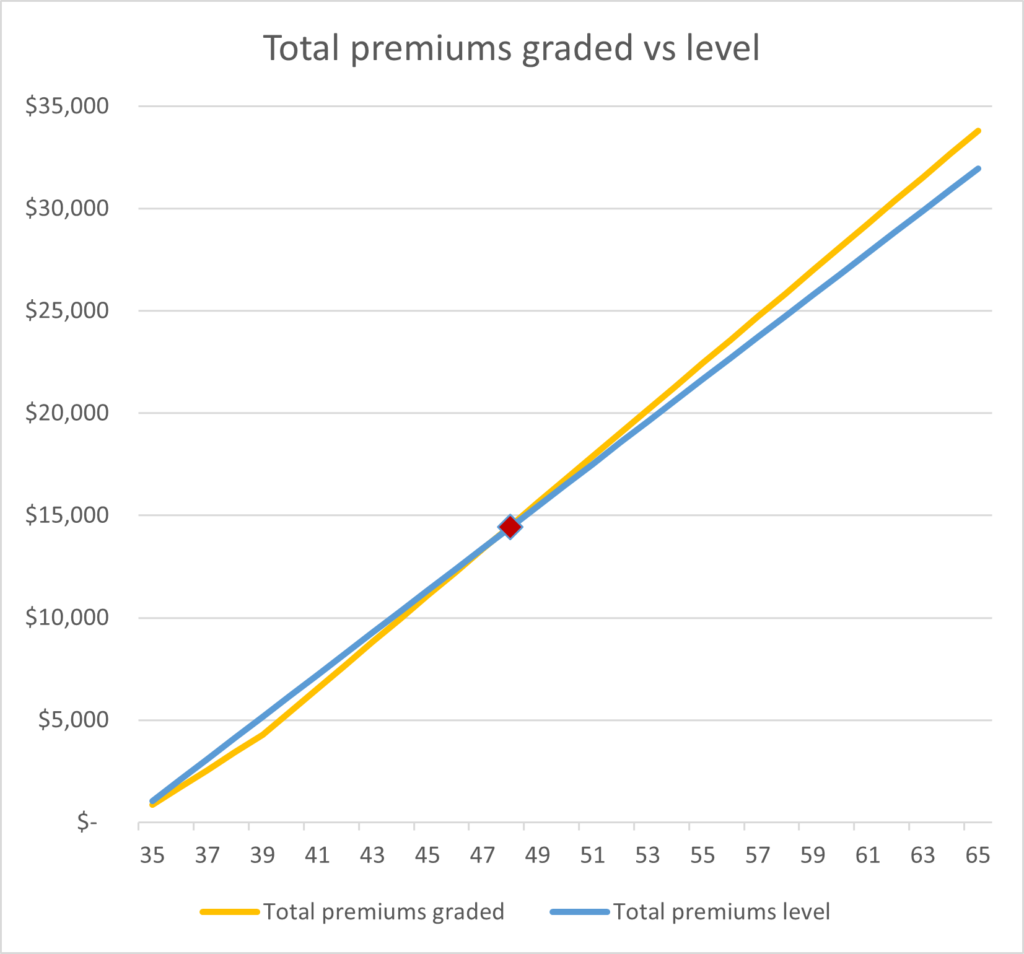Table of contents
Long-term disability insurance replaces your income if you can’t work in your occupation due to an injury or illness. But while many people understand the importance of it in protecting their financial plan, many neglect it because of its cost.
But did you know there is a way to lower your initial cost? Besides level premiums, for which premiums remain constant throughout the lifetime of the disability policy, there are also graded premiums.
In this post, we pit graded vs level premiums to see which one comes out on top. Then you can decide which one is suited for you.
- Key takeaways:
- The graded premium structure begins with a lower initial cost and increases gradually over time.
- In contrast, level premiums offer fixed payments for the duration of the policy, typically until age 65.
- Generally, young professionals who are still growing their income should choose a graded policy, while more established individuals may benefit from a level policy.

How Does Long-Term Disability Insurance Work?
Every day, we face the risk of injury or illness. While many of these morbidities are minor, some may keep you out of work for months or even years. Long-term disability insurance is a way for you to transfer the risk of illness or injury to an insurance company.
In exchange for premiums, the insurance company will pay you a monthly benefit if you become disabled in your own occupation. Although other options are available, the benefit usually starts after a 90-day waiting period and has a benefit period of age 65.
The benefit ranges from 50-80% of your income, depending on your tax bracket. Because you don’t have to pay tax on the benefits, disability insurance protects your financial plan by replacing most of your income.
What factors affect your disability insurance premiums?
What one person pays for a disability insurance policy can drastically differ from another. That’s because many factors affect your premiums. These include age, gender, smoking status, occupation, and plan design.
Although many of these factors are fixed, you can choose the plan design. Want to lower your premiums? Choose a longer waiting period and shorter benefit period. You can also pass on the optional riders like the cost of living adjustment and return of premium riders. Although your disability insurance policy will be much weaker without these bells and whistles, you’ll still have some basic coverage if you become disabled.
But what if you wanted to keep the riders and reduce your premium? With the graded premium option, you can have your cake and eat it too.
What Are Your Disability Insurance Premium Options?
When you buy a disability insurance policy, you have two premium payment options: level and graded premium. What are they and which one should you choose?
What is graded premium disability insurance?
With a graded premium structure (also called step rate), your premium payments start lower in the first five years. After the initial five-year period, the premium increases to a higher price for the remainder of the policy.
The lower premium in the early years is especially suitable for young professionals who are just beginning their practice and haven’t reached their peak earning power. Self-employed individuals and small business owners who are not yet established can also benefit from lower expenses for several years.
How much lower are the premiums in the first five years? For example, let’s look at a 35-year-old male non-smoker getting $2,500 in monthly benefits. With graded premiums, he will pay $71.29/month in the first five years. After that, his premiums will rise to $94.63/month. Then, it will stay at the same amount until he reaches 65.
What is level premium disability insurance?
As the name suggests, the level premium option has fixed payments for the entirety of the policy. Although it starts higher than graded premiums, you have the advantage of knowing you will pay the same amount for the policy’s life.
Level premiums are suitable for people established in their careers and earning a higher income than when they started. Their stronger financial situation means they can afford higher premiums.
Using the same 35-year-old insured, he will pay $85.91/month with the level premium option. The price will remain constant until age 65.
Graded or level premium: which should you get?
As mentioned above, professionals and self-employed individuals who are not yet established in their profession may want to choose the graded premium option. They may want to use the savings to reinvest in their business, pay for expenses, or keep more money in their pocket.
On the other hand, people who want to pay less money over the policy’s life will want to choose the level premium option. Although it will initially cost more, the fixed payments of level premiums win out over the long term.
Also, people who aim for early retirement may opt for graded premiums since they won’t be paying the higher premiums until age 65. If you’re fortunate enough to reach financial independence early, you can drop your disability insurance policy and self-insure.
One way to compare your options is to find the breakeven age or breakeven point. This is when the total premiums paid for the graded policy exceed the total premiums for the level policy. Because the breakeven point will differ for everybody, you won’t know which one to get until you’re presented with quotes.
Here is a graph showing the breakeven age using the 35-year-old insured. The breakeven point is in the 14th year at age 48 when the total premium paid for the graded policy exceeds that of the level one.

Will your level premiums ever increase?
Did you know your premiums can increase even if you select a level premium policy? There are two reasons why this can happen.
Guaranteed renewable
First, you should know that some disability insurance policies are guaranteed renewable. This means while the insurance company can’t cancel the disability policy, it can raise your rates.
However, insurers can’t just single you out for a premium increase. It has to raise rates for an entire class of disability insurance policies. A common reason for rate increases is higher than expected claim experience.
Non-cancellable
Besides guaranteed renewable, you may also come across disability insurance policies that are non-cancellable. These are superior to guaranteed renewable because the insurer cannot cancel your policy nor raise rates on you. The only downside is these typically cost more than their guaranteed renewable counterpart.
Future increase option
Your premium may also go up if you exercise a future increase option. Also commonly called the future income or insurability option, this lets you buy more coverage later. As an optional disability insurance rider, the future insurability option is a must-have if you’re beginning your career and expect much higher earnings as you progress.
Which insurance companies offer graded premiums?
While most insurers have a graded premium option, not all are created equal. For example, RBC Insurance starts with a lower premium for five years or age 30, whichever is later. It also only lets you buy it up to age 35.
On the other hand, Canada Life lets you purchase it up to age 45 and has a lower price for five years, no matter your age. Similarly, iA Financial Group also has graded premiums. However, it doesn’t have a maximum age to purchase.
Desjardins prices it similar to a term-10 life insurance policy. This means that the premium gradually increases in 10-year increments. While the first renewal might not be too high, you’ll face a much higher payment a few decades later. However, you can convert the graded premium to level premiums. On your policy anniversary, you can change it based on your attained age, which is your age at the time of conversion.
Need A Personalized Long-Term Disability Insurance Quote?
Now that you know the difference between graded and level premiums, do you know which one to purchase?
If you’re curious about your specific costs, feel free to reach out at info@briansoinsurance.com or 604-928-1628 for a free, no-obligation customized quote. We’ll show you how much graded and level premiums will be for you based on your age, gender, smoking status, occupation, and plan design.
Get Your Disability Insurance Quote Now
While we make every effort to keep our site updated, please be aware that timely information on this page, such as quote estimates, or pertinent details about companies, may only be accurate as of its last edit day. Brian So Insurance and its representatives do not give legal or tax advice. Please consult your own legal or tax adviser. This post is a brief summary for indicative purposes only. It does not include all terms, conditions, limitations, exclusions, and other provisions of the policies described, some of which may be material to the policy selection. Please refer to the actual policy documents for complete details which can be provided upon request. In case of any discrepancy, the language in the actual policy documents will prevail. A.M. Best financial strength ratings displayed are not a warranty of a company’s financial strength and ability to meet its obligations to policyholders.

